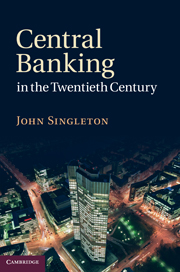Book contents
- Frontmatter
- Contents
- List of illustrations
- Acknowledgements
- List of abbreviations
- 1 A beginner's guide to central banking
- 2 Very boring guys?
- 3 Wind in the willows: the small world of central banking c. 1900
- 4 Something for everyone: new central banks, 1900–1939
- 5 A series of disasters: central banking, 1914–1939
- 6 The mysteries of central bank cooperation
- 7 The first central banking revolution
- 8 No time for cosmic thinkers: Central banking in the ‘Keynesian’ era
- 9 Rekindling central bank cooperation in the Bretton Woods era
- 10 The goose that lays the golden egg: Central banking in developing countries
- 11 The horse of inflation
- 12 The second central banking revolution: Independence and accountability
- 13 Reputations at stake: financial deregulation and instability
- 14 Inflation targeting: the holy grail?
- 15 The long march to European monetary integration
- 16 A world with half a million central bankers
- References
- Index
3 - Wind in the willows: the small world of central banking c. 1900
Published online by Cambridge University Press: 04 February 2011
- Frontmatter
- Contents
- List of illustrations
- Acknowledgements
- List of abbreviations
- 1 A beginner's guide to central banking
- 2 Very boring guys?
- 3 Wind in the willows: the small world of central banking c. 1900
- 4 Something for everyone: new central banks, 1900–1939
- 5 A series of disasters: central banking, 1914–1939
- 6 The mysteries of central bank cooperation
- 7 The first central banking revolution
- 8 No time for cosmic thinkers: Central banking in the ‘Keynesian’ era
- 9 Rekindling central bank cooperation in the Bretton Woods era
- 10 The goose that lays the golden egg: Central banking in developing countries
- 11 The horse of inflation
- 12 The second central banking revolution: Independence and accountability
- 13 Reputations at stake: financial deregulation and instability
- 14 Inflation targeting: the holy grail?
- 15 The long march to European monetary integration
- 16 A world with half a million central bankers
- References
- Index
Summary
At the end of the nineteenth century … ‘central bank’ meant scarcely more than a single bank distinguished from others by unique public responsibilities eclipsing its commercial interests.
R. S. Sayers (1976, vol. I: 1)To mark the 100th anniversary of the publication of ‘The Wind in the Willows’ on 8 October 1908, the Bank [of England]'s Museum has opened a new, permanent display celebrating the career of its author, Kenneth Grahame, who worked at the Bank for thirty years … John Keyworth, Curator of the Museum, said ‘Grahame's Bank career is little-known, but it is very likely that his thirty-year career had some influence on his writing; either the direct influence of colleagues on the famous characters he created or the atmosphere of life at the grand old institution imbuing his work.’
Bank of England (2008)The central banking world was small and rather stuffy at the start of the twentieth century. But there were interludes of excitement. The Times of 25 November 1903 reported a ‘Shooting Outrage at the Bank of England’. A visitor asked for the previous governor, and was taken to see the Bank's secretary, none other than Kenneth Grahame. He subsequently pulled out a gun and fired several times at Grahame. The shots missed, and the plucky central banker overpowered his assailant and locked him in a waiting room. According to The Times the gunman expressed ‘Socialistic views’ when interviewed by police, and was charged with ‘Wandering, deemed to be a lunatic’.
- Type
- Chapter
- Information
- Central Banking in the Twentieth Century , pp. 34 - 49Publisher: Cambridge University PressPrint publication year: 2010



